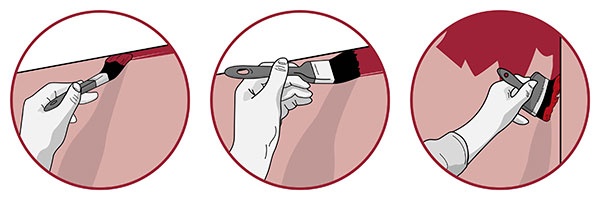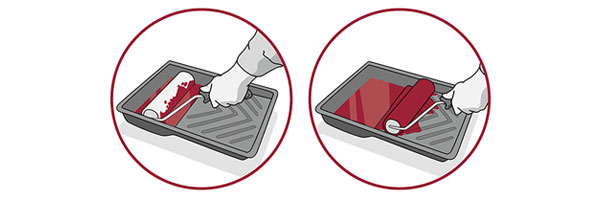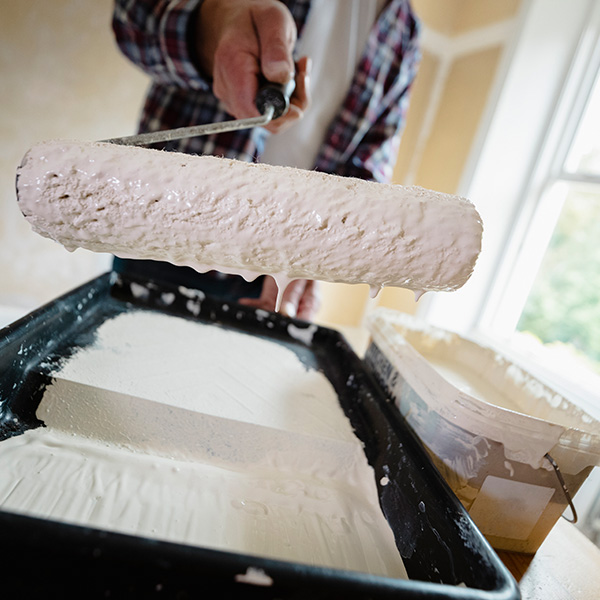Refreshing your home with a new lick of paint can completely transform the look & feel of your rooms! With the right kit, a bit of know-how, and some time, you can paint your walls yourself without stress. Brushes at the ready – let’s get to work!
 By Alex
By Alex- 23rd July 2024
- 5min read
This blog was updated on 24th October 2025
Get Shopping!
Let’s go over the bits of kit that you’ll need for a professional looking paint project:
- Paint: you won’t get far without this
- Paint brush: used for ‘cutting in’ paint around the edges of your wall and around sockets and light fixtures
- Paint roller & tray: easily applies paint over large surfaces
- Filler: for filling in holes & imperfections in your wall
- Scraper: used to apply filler for a flat surface
- Sandpaper: used to smooth out filler and/or remove old paint
- Sugar soap: a must have for cleaning walls before painting
- Primer/undercoat: use these first to really make your colour pop!
- Masking tape: for neat lines on top of your skirting boards & edges
- Dust sheets: to protect your furniture & flooring
When it comes to choosing your paint, it’s a great idea to grab some tester pots to see which looks best in your space.
Interior paint comes in a variety of different finishes. To learn more about these, as well as what the difference is between a primer and an undercoat, visit our indoor paint buying guide.
Before you start
Move as much furniture out of the room as you can. Cover any remaining furniture and your flooring with dust sheets to avoid unsightly spills and splashes.
Prep your walls
Use your filler to smooth out any cracks or holes in your wall. Once it’s dry, grab your sandpaper to buff it down to a perfectly smooth finish. So far, so good!
If you’re painting over the top of an old paint job which has shine, such as silk or gloss, you should go over the entire surface with medium grit sandpaper to dull the finish. You don’t have to remove it entirely; this is hard work and takes ages! Just enough to remove the shine and give the new paint or undercoat something to stock to. Any flaking paint can be removed with your scraper.
Next, clean your walls with a wet sponge and some diluted sugar soap. Work the soap around the wall before wiping it clean with fresh water and leaving it to dry fully before you carry on.
All of this can be done the night before, so you can hit the ground running and get painting the next day!
Tape
Grab your masking tape and use it to cover up plug sockets, light fixtures, and skirting boards. If you’re only painting one wall, lay some masking tape along the side and top of the wall for a neat finish.
To prime, or not to prime?
We’d recommend using a primer on freshly plastered or bare wooden walls to give your paint a good surface to stick to. They’re also a good idea if you’re painting over a gloss finish.
Undercoats create a solid base so that the colour of your paint can really pop, and cover up imperfections brilliantly. Use them on surfaces which are already painted or primed, especially if you’re painting over a wall which is darker than the paint you’re using.
How much paint to buy
Depending on the size of your painting project, you may need more than 1 tin of paint. No one wants to risk running out halfway through, or ending up with a tonne of tins cluttering up the home!
Our paint calculator is here to help! Simply add the measurements of all the walls you're looking to paint, and we'll tell you how much paint you'll need, with a little extra for good measure. No more guesswork!
Using a paint brush
Give your paint a good old mix before using. Any stick will do – just make sure you keep it somewhere safe, as it will become a family heirloom in years to come.
It’s time for ‘cutting in’! This is a fancy painting term for using a paint brush to apply paint around the edges of your wall, as well as around fixtures, sockets, and anywhere else that a roller can’t reach.
Simply dip the brush into your paint until it reaches halfway up the bristles. Tap or scrape any excess on the inside of the paint tin before carefully brushing the paint along the surface in long, confident strokes.
Go over your paint with long strokes to even out the finish and remove any streaks.

Using a roller
Next, fill your paint try about halfway with your paint. Dip your roller in and roll it around the textured section of your tray to evenly coat your roller with paint. If there’s too much paint on your roller, it can lead to an uneven finish – and paint will drip everywhere!
Use your roller to apply paint to your wall using long, vertical strokes. Try and roll as far in to the sections that you ‘cut in’ as possible.
Top tip: Paint over your ‘cut in’ sections while they’re still wet for an even coating!
For a pro finish, place your roller (without any paint applied) in the top corner of your wall and roll straight down with very little pressure. Once you get to the bottom, repeat across the length of the wall, slightly overlapping with the previous line. Top work!
Most paints recommend applying 2 coats, but check your tin to see what it recommends.

How to paint a ceiling
A nice, crisp white is a good colour for your ceiling as it lightens the room, but a darker colour can work nicely for home offices and bedrooms – any room that could do with a touch of extra ‘cosy’.
Painting your ceiling is much the same as painting your walls, but be careful not to overload your brushes and rollers, or you’ll end up dripping paint on the floor – or yourself.
Begin by masking around the edges of the wall and any fixtures that may get in your way. Cut in around the edges as normal.
For the main section of the ceiling, you could use a normal paint roller and a ladder, though this can take some time and lots of journeys up and down a ladder. An easier way is to grab a paint roller with an extendable pole so you can breeze through it!
Open some windows and let it dry for a few hours (or overnight – just remember to close the windows) before applying a second coat.
The big clean up
You’re almost done! Your walls will take a few hours to dry fully, so crack open a window but keep the door closed in case of inquisitive kids or pets.
Take this time to clean your brushes and rollers, and store your paint away in a cool, dry place – you never know when you may need it again!

There you have it! Painting your walls is easier than you think.
Shop our entire painting and decorating range on wilko.com, and don’t forget to share your DIY projects with us on Facebook, Instagram, TikTok or X